Connect With Us
Blog
Blog
Arthritis Can Cause Pain in the Feet and Ankles
Heel Pain Causes

Heel pain is a common issue that can be caused by several underlying conditions. One of the most frequent causes is plantar fasciitis, an inflammation of the thick band of tissue that runs along the bottom of the foot. This condition often results from overuse, improper footwear, or excessive pressure on the feet. Another cause of heel pain is Achilles tendinitis, which occurs when the tendon connecting the calf muscles to the heel becomes inflamed. Heel spurs, which are calcium deposits on the heel bone, can also lead to pain. Many people experience increased discomfort in the morning because the tissues in the foot tighten overnight. When stepping out of bed, the sudden pressure can strain these stiff tissues, causing sharp pain. As the day progresses and the foot warms up, the pain may decrease, but it can return after long periods of standing or walking. If you have heel pain, it is strongly suggested that you promptly consult a podiatrist who can determine what the cause is, and offer appropriate relief and treatment remedies.
Many people suffer from bouts of heel pain. For more information, contact Julie Jurd-Sadler, DPM of Progressive Podiatry. Our doctor can provide the care you need to keep you pain-free and on your feet.
Causes of Heel Pain
Heel pain is often associated with plantar fasciitis. The plantar fascia is a band of tissues that extends along the bottom of the foot. A rip or tear in this ligament can cause inflammation of the tissue.
Achilles tendonitis is another cause of heel pain. Inflammation of the Achilles tendon will cause pain from fractures and muscle tearing. Lack of flexibility is also another symptom.
Heel spurs are another cause of pain. When the tissues of the plantar fascia undergo a great deal of stress, it can lead to ligament separation from the heel bone, causing heel spurs.
Why Might Heel Pain Occur?
- Wearing ill-fitting shoes
- Wearing non-supportive shoes
- Weight change
- Excessive running
Treatments
Heel pain should be treated as soon as possible for immediate results. Keeping your feet in a stress-free environment will help. If you suffer from Achilles tendonitis or plantar fasciitis, applying ice will reduce the swelling. Stretching before an exercise like running will help the muscles. Using all these tips will help make heel pain a condition of the past.
If you have any questions please contact our offices located in Ijamsville and Mouth Airy, MD . We offer the newest diagnostic and treatment technologies for all your foot and ankle needs.
Causes and Types of Surgery for Ingrown Toenails
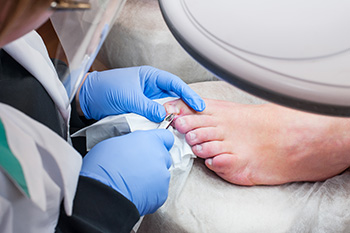
Ingrown toenails occur when the edges or corners of a toenail grow into the surrounding skin, leading to pain, swelling, and sometimes infection. Common causes of ingrown toenails include improper nail trimming, wearing tight footwear, or an inherited abnormal nail shape. In some cases, trauma or injury to the toe can also contribute to the condition. When conservative treatments, such as soaking the foot or using topical antibiotics, do not provide relief, surgery may be necessary to address the issue. There are different types of ingrown toenail surgery, with the most common being partial nail avulsion, where a portion of the nail is removed to relieve pressure and allow healing. Another procedure, known as matrixectomy, involves removing the nail root to prevent the ingrown toenail from recurring. If you have an ingrown toenail that is causing pain and discomfort, it is suggested that you consult a podiatrist who can discuss the benefits of this type of foot surgery.
Foot surgery is sometimes necessary to treat a foot ailment. To learn more, contact Julie Jurd-Sadler, DPM of Progressive Podiatry. Our doctor will assist you with all of your foot and ankle needs.
When Is Surgery Necessary?
Foot and ankle surgery is generally reserved for cases in which less invasive, conservative procedures have failed to alleviate the problem. Some of the cases in which surgery may be necessary include:
- Removing foot deformities like bunions and bone spurs
- Severe arthritis that has caused bone issues
- Cosmetic reconstruction
What Types of Surgery Are There?
The type of surgery you receive will depend on the nature of the problem you have. Some of the possible surgeries include:
- Bunionectomy for painful bunions
- Surgical fusion for realignment of bones
- Neuropathy decompression surgery to treat nerve damage
Benefits of Surgery
Although surgery is usually a last resort, it can provide more complete pain relief compared to non-surgical methods and may allow you to finally resume full activity.
Surgical techniques have also become increasingly sophisticated. Techniques like endoscopic surgery allow for smaller incisions and faster recovery times.
If you have any questions please feel free to contact our offices located in Ijamsville and Mouth Airy, MD . We offer the newest diagnostic and treatment technologies for all your foot and ankle needs.
How Obesity Affects the Feet
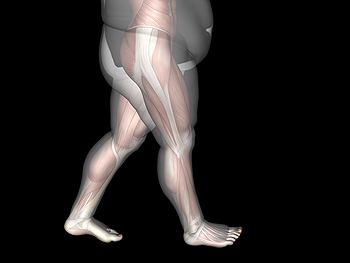
Obesity can impact the foot and ankle due to the added weight and increased pressure. The excess weight can lead to joint strain and increased wear on the bones, particularly in the feet and ankles. Over time, this added stress can contribute to the development of arthritis, causing pain, swelling, and limited mobility. Musculoskeletal problems, such as tendonitis or plantar fasciitis, are also more common in individuals who are obese due to the constant pressure on the foot structures. Walking up a flight of stairs or on an incline can further worsen this pressure, increasing ankle stress by four to six times compared to walking on level ground. This added strain can accelerate joint deterioration and lead to more severe foot and ankle conditions, making it vital for individuals with obesity to manage their weight and seek proper care for their feet. If you are overweight and have foot or ankle pain, it is suggested that you consult a podiatrist for treatment.
Obesity has become very problematic at this point in time and can have extremely negative effects on the feet. If you’re an obese individual and are concerned about your feet, contact Julie Jurd-Sadler, DPM from Progressive Podiatry. Our doctor can provide the care you need to keep you pain-free and on your feet.
Obesity and Your Feet
Since your feet are what support your entire weight when standing, any additional weight can result in pain and swelling. Being overweight is one of the main contributors to foot complications.
Problems & Complications
Extra Weight – Even putting on just a few extra pounds could create serious complications for your feet. As your weight increases, your balance and body will shift, creating new stresses on your feet. This uneven weight distribution can cause pain, even while doing the simplest tasks, such as walking.
Diabetes – People who are overweight are at serious risk of developing type-2 diabetes, which has a drastic impact on the health of your feet. As you get older, your diabetes might worsen, which could lead to loss of feeling in your feet, sores, and bruises. You could also become more prone to various infections.
Plantar fasciitis – Pressure and stress that is placed on muscles, joints, and tendons can trigger plantar fasciitis, which is an inflammation of tissue that forms along the bottom of the foot.
If you have any questions please feel free to contact our offices located in Ijamsville and Mouth Airy, MD . We offer the newest diagnostic and treatment technologies for all your foot and ankle needs.
Breaking in New Shoes to Prevent Foot Blisters

Breaking in new shoes properly is essential to prevent foot blisters and discomfort. When shoes are too stiff or tight, they can cause friction against the skin, leading to blisters. To avoid this, start by wearing the shoes for short periods around the house. This allows your feet to adjust gradually without putting too much pressure on them. You can also soften the shoes by using a leather conditioner or applying heat with a hairdryer to make the material more flexible. Wearing socks that cushion and reduce friction can help protect the skin as you break in the shoes. Additionally, using blister pads or moleskin on areas prone to rubbing provides extra protection. If you have developed one or more foot blisters, it is suggested that you consult a podiatrist who can treat existing blisters, and guide you on additional ways to prevent them while wearing new shoes.
Blisters may appear as a single bubble or in a cluster. They can cause a lot of pain and may be filled with pus, blood, or watery serum. If your feet are hurting, contact Julie Jurd-Sadler, DPM of Progressive Podiatry. Our doctor can provide the care you need to keep you pain-free and on your feet.
Foot Blisters
Foot blisters are often the result of friction. This happens due to the constant rubbing from shoes, which can lead to pain.
What Are Foot Blisters?
A foot blister is a small fluid-filled pocket that forms on the upper-most layer of the skin. Blisters are filled with clear fluid and can lead to blood drainage or pus if the area becomes infected.
Symptoms
(Blister symptoms may vary depending on what is causing them)
- Bubble of skin filled with fluid
- Redness
- Moderate to severe pain
- Itching
Prevention & Treatment
In order to prevent blisters, you should be sure to wear comfortable shoes with socks that cushion your feet and absorb sweat. Breaking a blister open may increase your chances of developing an infection. However, if your blister breaks, you should wash the area with soap and water immediately and then apply a bandage to the affected area. If your blisters cause severe pain it is important that you call your podiatrist right away.
If you have any questions, please feel free to contact our offices located in Ijamsville and Mouth Airy, MD . We offer the newest diagnostic and treatment technologies for all your foot care needs.
Gout Pain Can Be Managed
Athlete's Foot and Its Potential to Spread
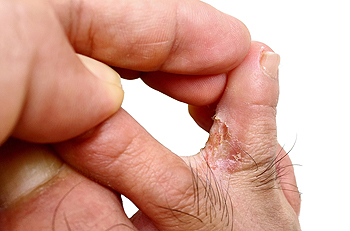
Athlete's foot is a fungal infection that commonly affects the skin on the feet, particularly between the toes. It is caused by fungi that thrive in warm, moist environments, such as sweaty socks and shoes. Symptoms include itching, redness, peeling, and sometimes blisters. While athlete's foot primarily affects the feet, it can spread to other areas of the body if not treated properly. The infection can spread to the hands if a person touches the affected area and then touches other parts of their body. Additionally, the fungus can spread to the nails or even the groin area in some cases. It is important to maintain good foot hygiene and treat the infection promptly with antifungal medications to prevent it from spreading to other areas. If you have developed athlete’s foot, it is suggested that you promptly consult a podiatrist who can effectively treat this condition, which often includes prescribed medication.
Athlete’s foot is an inconvenient condition that can be easily reduced with the proper treatment. If you have any concerns about your feet and ankles, contact Julie Jurd-Sadler, DPM from Progressive Podiatry. Our doctor will treat your foot and ankle needs.
Athlete’s Foot: The Sole Story
Athlete's foot, also known as tinea pedis, can be an extremely contagious foot infection. It is commonly contracted in public changing areas and bathrooms, dormitory style living quarters, around locker rooms and public swimming pools, or anywhere your feet often come into contact with other people.
Solutions to Combat Athlete’s Foot
- Hydrate your feet by using lotion
- Exfoliate
- Buff off nails
- Use of anti-fungal products
- Examine your feet and visit your doctor if any suspicious blisters or cuts develop
Athlete’s foot can cause many irritating symptoms such as dry and flaking skin, itching, and redness. Some more severe symptoms can include bleeding and cracked skin, intense itching and burning, and even pain when walking. In the worst cases, Athlete’s foot can cause blistering as well. Speak to your podiatrist for a better understanding of the different causes of Athlete’s foot, as well as help in determining which treatment options are best for you.
If you have any questions please feel free to contact our offices located in Ijamsville and Mouth Airy, MD . We offer the newest diagnostic and treatment technologies for all your foot and ankle needs.
Ankle Pain Caused by Arthritis

Ankle pain is often a symptom of arthritis, with osteoarthritis, rheumatoid arthritis, and gout being some of the leading causes. Osteoarthritis occurs when the protective cartilage in the ankle joint breaks down, causing pain, stiffness, and swelling. Rheumatoid arthritis, an autoimmune condition, causes inflammation in the joints, leading to pain and limited mobility. Gout, a type of arthritis caused by a buildup of uric acid crystals, often affects the ankle, causing sudden, intense pain and redness. Arthritis in the ankle can significantly impact daily activities, making walking or standing difficult. Over time, untreated arthritis can lead to joint deformities, further restricting movement. Treatment for arthritis-related ankle pain typically includes taking anti-inflammatory medications, targeted exercises, and lifestyle changes like weight management. In more severe cases, surgery may be necessary. A podiatrist can accurately diagnose the type of arthritis and create a personalized treatment plan to manage pain and improve mobility. If you are experiencing ankle pain from arthritis, it is suggested that you schedule an appointment with a podiatrist.
Ankle pain can have many different causes and the pain may potentially be serious. If you have ankle pain, consult with Julie Jurd-Sadler, DPM from Progressive Podiatry. Our doctor will assess your condition and provide you with quality foot and ankle treatment.
Ankle pain is any condition that causes pain in the ankle. Due to the fact that the ankle consists of tendons, muscles, bones, and ligaments, ankle pain can come from a number of different conditions.
Causes
The most common causes of ankle pain include:
- Types of arthritis (rheumatoid, osteoarthritis, and gout)
- Ankle sprains
- Broken ankles
- Achilles tendinitis
- Achilles tendon rupture
- Stress fractures
- Tarsal tunnel syndrome
- Plantar fasciitis
Symptoms
Symptoms of ankle injury vary based upon the condition. Pain may include general pain and discomfort, swelling, aching, redness, bruising, burning or stabbing sensations, and/or loss of sensation.
Diagnosis
Due to the wide variety of potential causes of ankle pain, podiatrists will utilize a number of different methods to properly diagnose ankle pain. This can include asking for personal and family medical histories and of any recent injuries. Further diagnosis may include sensation tests, a physical examination, and potentially x-rays or other imaging tests.
Treatment
Just as the range of causes varies widely, so do treatments. Some more common treatments are rest, ice packs, keeping pressure off the foot, orthotics and braces, medication for inflammation and pain, and surgery.
If you have any questions, please feel free to contact our offices located in Ijamsville and Mouth Airy, MD . We offer the newest diagnostic and treatment technologies for all your foot care needs.
How to Measure Your Foot When Buying New Shoes
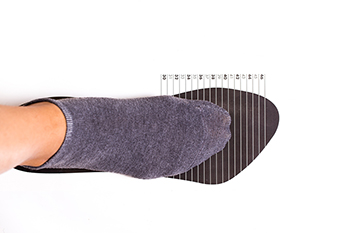
Measuring your foot accurately is essential when buying new shoes to ensure a proper fit and comfort. Start by placing your foot on a flat surface with your heel against a wall. Use a ruler or measuring tape to measure the length of your foot from the heel to the tip of your longest toe. It is also important to measure the width of your foot across the widest part, usually near the toes. Take measurements in the evening when your feet are more likely to be swollen, as this will help avoid buying shoes that are too tight. When purchasing shoes, make sure there is enough space in the toe box for your toes to move freely and that the shoes fit snugly around the heel without slipping. If you have foot pain from wearing shoes that do not fit correctly, it is suggested that you consult a podiatrist who can offer effective relief tips, and guide you on how to properly measure your feet.
Getting the right shoe size is an important part of proper foot health. Seek the assistance of Julie Jurd-Sadler, DPM from Progressive Podiatry. Our doctor will provide the care you need to keep you pain-free and on your feet.
Getting the Right Shoe Size
There are many people who wear shoes that are the incorrect size, negatively affecting their feet and posture. Selecting the right shoes is not a difficult process, so long as you keep several things in mind when it comes to choosing the right pair.
- When visiting the shoe store, use the tools available to measure your foot.
- Be sure there is ‘wiggle room’. There should be about an inch between your toes and the tip of your shoes.
- Do not always assume you are the same size, as manufacturers run differently.
- Purchase shoes later in the day, as your feet swell as the day progresses.
- If a shoe is not comfortable, it is not suitable. Most shoes can’t be ‘broken in’, and comfort should be the ultimate goal when it comes to choosing the right pair of shoes
As our feet hold our body weight and keep us moving, it is important to treat them right. Picking the right pair of shoes can provide your feet comfort and mobility without pain.
If you have any questions, please feel free to contact our offices located in Ijamsville and Mouth Airy, MD . We offer the newest diagnostic and treatment technologies for all your foot care needs.
Plantar Fasciitis Care

Plantar fasciitis is a common cause of heel pain, often resulting in sharp pain in the bottom of the heel, especially with the first steps in the morning or after prolonged sitting. It occurs when the plantar fascia, a thick band of tissue connecting the heel to the toes, becomes inflamed due to overuse, wearing poor footwear, or excessive pressure. To manage plantar fasciitis, stretching exercises like calf stretches, toe stretches, and plantar fascia stretches can help relieve tension and improve flexibility. Strengthening exercises for the foot and ankle can also aid in recovery. Additionally, wearing supportive shoes and using orthotic insoles can provide extra cushioning and protect the heel from further strain. A podiatrist can recommend personalized treatments, including custom orthotics, and guide you through proper care to prevent recurrence. If you are struggling with heel pain from plantar fasciitis, it is suggested that you schedule an appointment with a podiatrist to develop an effective treatment plan.
Plantar fasciitis can be very painful and inconvenient. If you are experiencing heel pain or symptoms of plantar fasciitis, contact Julie Jurd-Sadler, DPM from Progressive Podiatry. Our doctor can provide the care you need to keep you pain-free and on your feet.
What Is Plantar Fasciitis?
Plantar fasciitis is the inflammation of the thick band of tissue that runs along the bottom of your foot, known as the plantar fascia, and causes mild to severe heel pain.
What Causes Plantar Fasciitis?
- Excessive running
- Non-supportive shoes
- Overpronation
- Repeated stretching and tearing of the plantar fascia
How Can It Be Treated?
- Conservative measures – anti-inflammatories, ice packs, stretching exercises, physical therapy, orthotic devices
- Shockwave therapy – sound waves are sent to the affected area to facilitate healing and are usually used for chronic cases of plantar fasciitis
- Surgery – usually only used as a last resort when all else fails. The plantar fascia can be surgically detached from the heel
While very treatable, plantar fasciitis is definitely not something that should be ignored. Especially in severe cases, speaking to your doctor right away is highly recommended to avoid complications and severe heel pain. Your podiatrist can work with you to provide the appropriate treatment options tailored to your condition.
If you have any questions please feel free to contact our offices located in Ijamsville and Mouth Airy, MD . We offer the newest diagnostic and treatment technologies for all your foot and ankle needs.
More...
Managing Heel Spurs

Bone spurs are bony growths that form along the edges of foot bones, often in areas where joints and ligaments meet. Heel spurs are a common type of bone spur, often causing pain and discomfort. They typically develop due to repetitive stress, aging, or conditions like arthritis, plantar fasciitis, or obesity. Over time, heel spurs can cause discomfort, particularly when they irritate nearby tissues. Common symptoms of heel spurs include pain, swelling, and inflammation, particularly when walking or standing for long periods. In some cases, certain types of bone spurs may not cause any symptoms and may only be discovered during an X-ray for another condition. Treatment for heel spurs may involve conservative measures like rest, anti-inflammatory medications, and custom orthotics to relieve pressure. In severe cases, targeted exercises or surgery may be necessary to remove the spur and restore function. A podiatrist can evaluate your condition, recommend appropriate treatments, and help manage pain. If you are experiencing foot pain or suspect a heel spur, it is suggested that you schedule an appointment with a podiatrist for a proper diagnosis and care plan.
Heel spurs can be incredibly painful and sometimes may make you unable to participate in physical activities. To get medical care for your heel spurs, contact Julie Jurd-Sadler, DPM from Progressive Podiatry. Our doctor will do everything possible to treat your condition.
Heels Spurs
Heel spurs are formed by calcium deposits on the back of the foot where the heel is. This can also be caused by small fragments of bone breaking off one section of the foot, attaching onto the back of the foot. Heel spurs can also be bone growth on the back of the foot and may grow in the direction of the arch of the foot.
Older individuals usually suffer from heel spurs and pain sometimes intensifies with age. One of the main condition's spurs are related to is plantar fasciitis.
Pain
The pain associated with spurs is often because of weight placed on the feet. When someone is walking, their entire weight is concentrated on the feet. Bone spurs then have the tendency to affect other bones and tissues around the foot. As the pain continues, the feet will become tender and sensitive over time.
Treatments
There are many ways to treat heel spurs. If one is suffering from heel spurs in conjunction with pain, there are several methods for healing. Medication, surgery, and herbal care are some options.
If you have any questions feel free to contact our offices located in Ijamsville and Mouth Airy, MD . We offer the latest in diagnostic and treatment technology to meet your needs.
Are You Suffering From Ingrown Toenails?
Common Areas and Solutions for Foot Pain

Foot pain affects millions of people, impacting mobility and quality of life. The most common areas for foot issues include the heel, arch, toes, and ball of the foot. Conditions like plantar fasciitis, bunions, and metatarsalgia frequently cause discomfort. It is estimated that nearly 75% of people experience foot pain at some point, with a higher prevalence in older adults and those with active lifestyles or jobs that require prolonged standing. Self-assessment for foot pain can involve gently pressing on the affected area and noting if pain occurs with movement. Reduced mobility or swelling may signal underlying issues. Diagnosis typically involves a physical exam, sometimes with imaging like X-rays. Treatment options vary, from rest to orthotics, targeted exercises, and, in severe cases, surgery. Early attention to foot pain helps prevent chronic discomfort and supports long-term mobility. If you have foot pain, it is suggested that you visit a podiatrist for a proper diagnosis and treatment options.
Foot Pain
Foot pain can be extremely painful and debilitating. If you have a foot pain, consult with Julie Jurd-Sadler, DPM from Progressive Podiatry. Our doctor will assess your condition and provide you with quality foot and ankle treatment.
Causes
Foot pain is a very broad condition that could be caused by one or more ailments. The most common include:
- Bunions
- Hammertoes
- Plantar Fasciitis
- Bone Spurs
- Corns
- Tarsal Tunnel Syndrome
- Ingrown Toenails
- Arthritis (such as Gout, Rheumatoid, and Osteoarthritis)
- Flat Feet
- Injury (from stress fractures, broken toe, foot, ankle, Achilles tendon ruptures, and sprains)
- And more
Diagnosis
To figure out the cause of foot pain, podiatrists utilize several different methods. This can range from simple visual inspections and sensation tests to X-rays and MRI scans. Prior medical history, family medical history, and any recent physical traumatic events will all be taken into consideration for a proper diagnosis.
Treatment
Treatment depends upon the cause of the foot pain. Whether it is resting, staying off the foot, or having surgery; podiatrists have a number of treatment options available for foot pain.
If you have any questions, please feel free to contact our offices located in Ijamsville and Mouth Airy, MD . We offer the newest diagnostic and treatment technologies for all your foot care needs.
Dealing With Cracked Heels
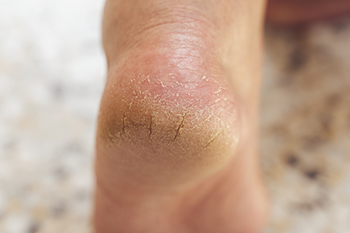
Cracked heels are a common foot condition characterized by dry, thickened skin that develops fissures around the edges of the heel. Common causes include prolonged standing, improper footwear, dry skin, and underlying health issues such as diabetes or eczema. Symptoms often include visible cracks, rough skin, discomfort, and sometimes bleeding or pain. If left untreated, cracked heels can lead to infections and more serious complications. Treatment involves moisturizing the feet regularly, using exfoliating scrubs to remove dead skin, and wearing supportive shoes to alleviate pressure. A podiatrist can provide specialized care, offering treatments such as professional debridement, customized orthotics, and tailored advice on foot care routines. If you are struggling with cracked heels, consulting a podiatrist is suggested. They can accurately assess your condition and develop a personalized treatment plan to restore your foot health.
If the skin on your feet starts to crack, you may want to see a podiatrist to find treatment. If you have any concerns, contact Julie Jurd-Sadler, DPM from Progressive Podiatry. Our doctor can provide the care you need to keep you pain-free and on your feet.
Cracked Heels
It is important to moisturize your cracked heels in order to prevent pain, bleeding, and infection. The reason cracked heels form is because the skin on the foot is too dry to support the immense pressure placed on them. When the foot expands, the dry skin on the foot begins to split.
Ways to Help Heal Them
- Invest in a good foot cream
- Try Using Petroleum Jelly
- Ease up on Soaps
- Drink Plenty of Water
Ways to Prevent Cracked Heels
- Moisturize After Showering
- Skip a Shower
- Keep Shower Water Lukewarm
- Don’t Scrub Your Feet
If you are unsure how to proceed in treating cracked heels, seek guidance from a podiatrist. Your doctor will help you with any questions or information you may need.
If you have any questions, please feel free to contact our offices located in Ijamsville and Mouth Airy, MD . We offer the newest diagnostic and treatment technologies for all your foot care needs.
Blog Archives
- April 2025
- March 2025
- February 2025
- January 2025
- December 2024
- November 2024
- October 2024
- September 2024
- August 2024
- July 2024
- June 2024
- May 2024
- April 2024
- March 2024
- February 2024
- January 2024
- December 2023
- November 2023
- October 2023
- September 2023
- August 2023
- July 2023
- June 2023
- May 2023
- April 2023
- March 2023
- February 2023
- January 2023
- December 2022
- November 2022
- October 2022
- September 2022
- August 2022
- July 2022
- June 2022
- May 2022
- April 2022
- March 2022
- February 2022
- January 2022
- December 2021
- November 2021
- October 2021
- September 2021
- August 2021
- July 2021
- June 2021
- May 2021
- April 2021
- March 2021
- February 2021
- January 2021
- December 2020
- November 2020
- October 2020
- September 2020
- August 2020
- July 2020
- June 2020
- May 2020
- April 2020
- March 2020
- February 2020
- January 2020
- December 2019
- November 2019



